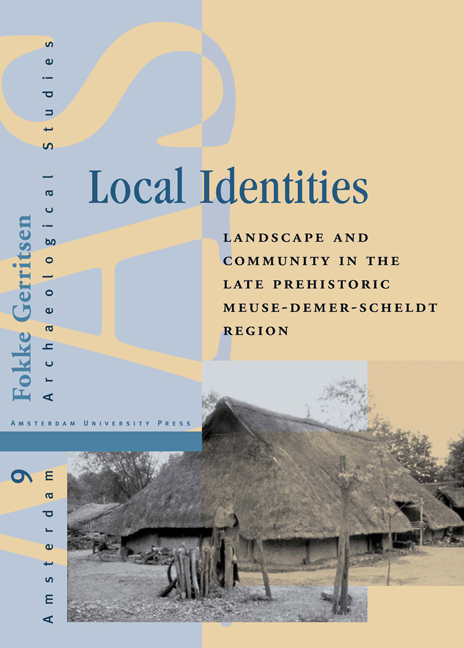Book contents
- Frontmatter
- Contents
- Acknowledgment
- 1 Introduction
- 2 Archaeology in a Sandy ‘Essen’ Landscape
- 3 The House and its Inhabitants
- 4 Local Communities and the Organisation of the Landscape
- 5 Micro-Regional and Regional Patterns of Habitation, Demography and land use
- 6 Landscape, Identity and Community in the First Millennium BC
- Abbreviations
- References
- Appendix 1 Meuse-Demer-Scheldt Region. Distribution of Urnfields
- Appendix 2 Catalogus of Urnfields
- Index of Geographical Names
4 - Local Communities and the Organisation of the Landscape
Published online by Cambridge University Press: 28 January 2021
- Frontmatter
- Contents
- Acknowledgment
- 1 Introduction
- 2 Archaeology in a Sandy ‘Essen’ Landscape
- 3 The House and its Inhabitants
- 4 Local Communities and the Organisation of the Landscape
- 5 Micro-Regional and Regional Patterns of Habitation, Demography and land use
- 6 Landscape, Identity and Community in the First Millennium BC
- Abbreviations
- References
- Appendix 1 Meuse-Demer-Scheldt Region. Distribution of Urnfields
- Appendix 2 Catalogus of Urnfields
- Index of Geographical Names
Summary
SETTLEMENT TERRITORIES AND LOCAL COMMUNITIES
INTRODUCTION
In many languages there are multiple terms to describe basic groups of rural dwellings, units in which most of the population of agricultural societies lives. Some terms have a meaning that stresses the geographical, others the social aspects (for example settlement versus community), although typically a combination of social, spatial or other contents is implied (hamlet, village, parish etc.). These are often primary organising features – although never the only one – of the larger bodies of societies.They are central elements in the construction of people's identities, in the transmission of ideas and values, and in the organisation of subsistence strategies, to name a few features. Deservedly, they have received much attention from geographers and anthropologists. It is the same with archaeologists, for whom in many regions and periods the settlement is a basic unit of analysis. In this study too, the logical next step of analysis after the farmstead and household is the settlement and especially its associated local community.
But having specified the object of study of this chapter, a problem of definition immediately looms large. As described in the previous chapter, farmsteads in the study region tend to be dispersed over the landscape throughout most of the Bronze Age and Iron Age, and nucleated settlements only began to develop in the last centuries of the first millennium BC (see section 4.5). How does one then define a settlement archaeologically? Even in the rare cases in which it is possible to point to several farmsteads whose distance from each other is significantly less than the distance to other farmsteads, the problems are not solved.The scale of excavations never allows one to be certain that a representative sample of the total number of dispersed farmsteads has been excavated, and moreover, the lack of precision in dating single farmsteads is too great to be able to suggest which farmsteads were contemporaneous.While it is quite possible to envisage an Iron Age settlement in the social sense, its geographical component is difficult to grasp through archaeological methods.
It has been recognised for some time in Dutch regional archaeology that a more appropriate analytical focus is not the settlement, but the settlement territory.
- Type
- Chapter
- Information
- Local IdentitiesLandscape and Community in the Late Prehistoric Meuse-Demer-Scheldt Region, pp. 109 - 198Publisher: Amsterdam University PressPrint publication year: 2003



